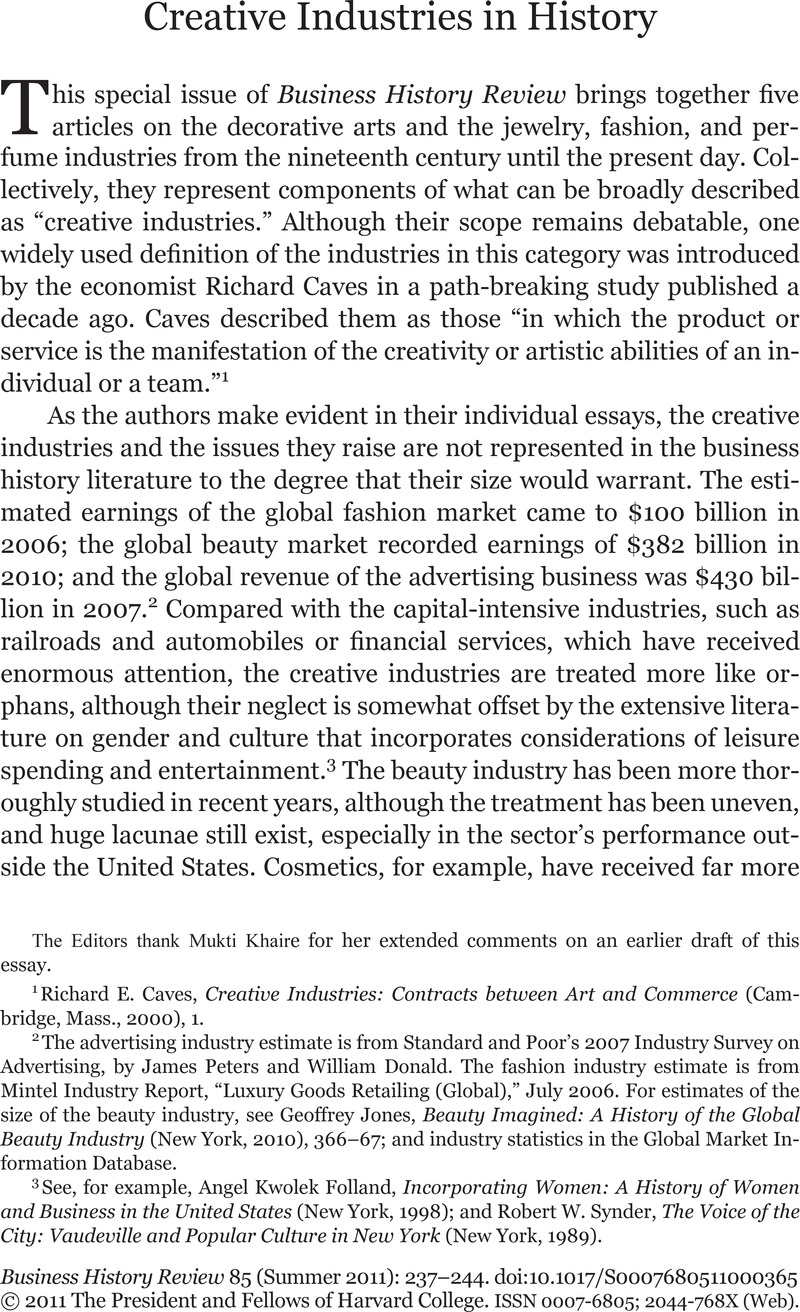Published online by Cambridge University Press: 28 June 2011

1 Caves, Richard E., Creative Industries: Contracts between Art and Commerce (Cambridge, Mass., 2000), 1Google Scholar.
2 The advertising industry estimate is from Standard and Poor's 2007 Industry Survey on Advertising, by James Peters and William Donald. The fashion industry estimate is from Mintel Industry Report, “Luxury Goods Retailing (Global),” July 2006. For estimates of the size of the beauty industry, see Jones, Geoffrey, Beauty Imagined: A History of the Global Beauty Industry (New York, 2010), 366–67Google Scholar; and industry statistics in the Global Market Information Database.
3 See, for example, Folland, Angel Kwolek, Incorporating Women: A History of Women and Business in the United States (New York, 1998)Google Scholar; and Synder, Robert W., The Voice of the City: Vaudeville and Popular Culture in New York (New York, 1989)Google Scholar.
4 The most important recent studies of the American beauty industry include Peiss, Kathy, Hope in a Jar (New York, 1998)Google Scholar; Scranton, Philip, ed., Beauty and Business: Commerce, Gender, and Culture in Modern America (New York, 2001)Google Scholar; and Walker, Susannah, Style and Status: Selling Beauty to African American Women, 1920–1975 (Lexington, Ky., 2007)CrossRefGoogle Scholar. For Europe, see especially Briot, Eugénie, “La Chimie des élégances: la parfumerie Parisienne au XIXe siècle: naissance d'une industrie du luxe,” unpublished PhD diss., Conservatoire National des Arts et Métiers, Centre d'Histoire des Techniques et de l'Environnement, 2008Google Scholar; Puig, Nuría, “The Search for Identity: Spanish Perfume in the International Market,” Business History 45, no. 3 (2003): 90–118CrossRefGoogle Scholar; Söderberg, Johan, Röda Lappar och Shinglat Hår: Konsumtionen av kosmetika i Sverige, 1900–1960 (Stockholm, 2001)Google Scholar; and Zdatny, Steven, Fashion, Work, and Politics in Modern France (New York, 2006)CrossRefGoogle Scholar. Jones, in Beauty Imagined, provides a global history of the industry since the nineteenth century.
5 On Paris, the classic historical study remains Steele, Valerie, Paris Fashion: A Cultural History (Oxford, 1998)CrossRefGoogle Scholar. Recent research, from a more business history perspective, includes Fields, Jill, An Intimate Affair: Women, Lingerie, and Sexuality (Berkeley, 2007)Google Scholar; Stewart, Mary Lynn, Dressing Modern Frenchwomen: Marketing Haute Couture, 1919–1939 (Baltimore, 2008)Google Scholar; Blaszczyk, Regina Lee, ed., Producing Fashion: Commerce, Culture and Consumers (Philadelphia, 2009)Google Scholar.
6 Bakker, Gerben, Entertainment Industrialized: The Emergence of the International Film Industry (Cambridge, U.K., 2008)CrossRefGoogle Scholar; Miskell, Peter, “The Film Industry in Twentieth Century Britain: Consumption Patterns, Government Regulation, and Firm Strategy,” in Business in Britain in the Twentieth Century, ed. Coopey, Richard and Lyth, Peter (Oxford, 2009), 306–29CrossRefGoogle Scholar; Miskell, Peter, “Resolving the Global Efficiency versus Local Adaptability Dilemma: U.S. Film Multinationals in their Largest Foreign Market in the 1930s and 1940s,” Business History 51, no. 3 (2009): 426–44CrossRefGoogle Scholar.
7 Hirsch, Paul M., “Processing Fads and Fashions: An Organization-Set Analysis of Cultural Industry Systems,” American Journal of Sociology 77, no. 4 (1972): 639–59CrossRefGoogle Scholar.
8 The most comprehensive compilations and review of these properties, which have been elucidated by various scholars separately, is provided by Caves, Creative Industries, 2–10.
9 See Bourdieu, Pierre, “The Field of Cultural Production, or: The Economic World Reversed,” Poetics 12, nos. 4–5 (1983): 311–56CrossRefGoogle Scholar, translated by Richard Nice. Also see Bourdieu, Pierre, “The Market of Symbolic Goods,” Poetics 14, nos. 1–2 (1985): 13–44CrossRefGoogle Scholar, translated by Rupert Swyer.
10 See, for example, Kawamura, Yuniya, The Japanese Revolution in Paris Fashion (New York, 2004)CrossRefGoogle Scholar; Holbrook, Morris and Addis, Michela, “Taste Versus the Market: An Extension of Research on the Consumption of Popular Culture,” Journal of Consumer Research 34, no. 5 (2007): 415–24CrossRefGoogle Scholar; Defillippi, Robert, Grabher, Gernot, and Jones, Candace, “Introduction to Paradoxes of Creativity: Managerial and Organizational Challenges in a Cultural Economy,” Journal of Organizational Behavior 28, no. 5 (2007): 511–21CrossRefGoogle Scholar; Baumann, Shyon, “Marketing, Cultural Hierarchy, and the Relevance of Critics: Film in the United States, 1935–1980,” Poetics 40, no. 4 (2002): 243–62CrossRefGoogle Scholar; Djelic, Marie-Laure and Ainamo, Antti, “The Co-evolution of New Organizational Forms in the Fashion Industry: A Historical and Comparative Study of France, Italy, and the United States,” Organization Science 10, no. 5 (1999): 363–86CrossRefGoogle Scholar; Van Rees, C. J., “How Reviewers Reach Consensus on the Value of Literary Works,” Poetics 16, nos. 3–4 (1987): 275–94CrossRefGoogle Scholar; Becker, Howard, Art Worlds (Los Angeles, 1982)Google Scholar.
11 Lampel, Joseph, Lant, Theresa, and Shamsie, Jamal, “Balancing Act: Learning from Organizing Practices in Cultural Industries,” Organization Science 11, no. 3 (2000): 263–69CrossRefGoogle Scholar.
12 Pratt, Andy C., “Cultural Industries and Public Policy: An Oxymoron?” International Journal of Cultural Policy 11 (2005): 29–44CrossRefGoogle Scholar. See also Jayne, Mark, “Creative Industries: The Regional Dimensions?” Environment and Planning: Government and Policy 23 (2005): 537–56CrossRefGoogle Scholar; and DeFillippi, Robert, Grabher, Gernot, and Jones, Candace, “Introduction to Paradoxes of Creativity: Managerial and Organizational Challenges in the Cultural Economy,” Journal of Organizational Behavior 28 (2007): 511–21CrossRefGoogle Scholar.
13 See especially Csikszentmihalyi, Mikhail and Csikszentmihalyi, I. S., Optimal Experience: Psychological Studies of Flow in Consciousness (New York, 1988)CrossRefGoogle Scholar. See also Bourdieu, “The Field”; and White, Harrison and White, Cynthia, Canvases and Careers: Institutional Change in the French Painting World (New York, 1965)Google Scholar.
14 See Thompson, Paul, Jones, Michael, and Warhurst, Chris, “From Conception to Consumption: Creativity and the Missing Managerial Link,” Journal of Organizational Behavior 28, no. 5 (2007): 625–40CrossRefGoogle Scholar.
15 See Greenberg's, Clement essay on avant garde and kitsch in Art and Culture: Critical Essays (Boston, 1961)Google Scholar.
16 See Gans, Herbert J., Popular Culture and High Culture: An Analysis and Evaluation of Taste (New York, 1974)Google Scholar. See also Caves, Creative Industries, 9.
17 Simmel, Georg, “Fashion,” American Journal of Sociology 62, no. 6 (1957): 541–58CrossRefGoogle Scholar.
18 The Modern Girl Around the World Research Group, The Modern Girl Around the World (Durham, N.C., 2008)Google Scholar.